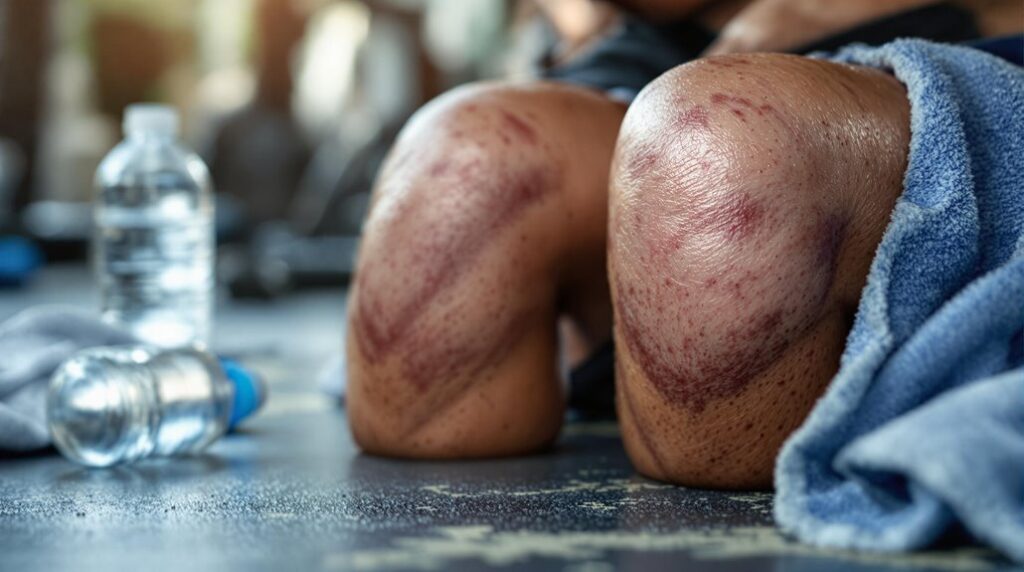If your knees hurt after a workout, it's often due to overuse, improper footwear, or rapid intensity increases. Common symptoms include sharp pain, swelling, or cracking sounds. To alleviate discomfort, rest, ice, elevate, and compress the knee. If pain lasts more than a week, worsens, or includes significant swelling, seek professional help. Strengthening muscles and improving footwear can also prevent future issues. There's more to understand about managing knee health effectively, including preventative strategies and treatment options.
Common Causes of Knee Pain After Exercise
When you engage in physical activity, there's a chance you might experience knee pain afterward, which can stem from several common causes. One major culprit is overuse, often referred to as runner's knee, resulting from repetitive stress and inflammation beneath the kneecap. This discomfort can worsen when you don't allow adequate rest between workouts. Additionally, improper footwear or sudden increases in workout intensity can lead to knee strain. If you're over 50 or have prior knee injuries, underlying conditions like osteoarthritis might be contributing factors. You may notice dull or sharp pain during and after exercise. If knee pain persists for more than a week, it's wise to consult a healthcare professional for a proper diagnosis and treatment plan.
Symptoms to Watch For
Knee pain after a workout can manifest through various symptoms that warrant attention. You might experience dull or sharp pain at the front, around, or behind the kneecap, often referred to as runner's knee. Swelling under the kneecap may indicate inflammation, especially when accompanied by persistent pain, and should prompt a consultation with a healthcare professional. Morning stiffness that improves with movement could suggest knee osteoarthritis, particularly in those over 50. Additionally, if you notice cracking or grating sensations during movement, along with feelings of weakness or instability, these may signal underlying issues like osteoarthritis or overuse injuries. If your knee pain lingers for more than a week after exercise, seeking medical advice is essential to prevent further complications.
Immediate Treatment Options
Experiencing knee pain after a workout can be distressing, but immediate treatment options are available to help alleviate discomfort and promote recovery. First, rest the affected knee and apply ice for 20 minutes at a time; this helps reduce swelling and discomfort. Elevate your knee above heart level to minimize swelling and encourage blood flow. Remember to wrap the ice in a towel to prevent direct skin contact, avoiding frostbite. Additionally, consider using an elastic bandage or knee sleeve for compression, ensuring it's not too tight to restrict circulation. If your pain persists after a week or is accompanied by severe swelling, it's essential to consult a healthcare professional for further evaluation.
When to Seek Professional Help
How can you determine whether your knee pain requires professional intervention? If your knee pain persists for more than a week despite rest and ice treatment, you should consult a GP or physiotherapist. Sudden severe pain, especially with swelling or instability, warrants immediate medical attention to rule out serious injuries like ligament tears. Additionally, if you notice a grinding or cracking sensation in your knee accompanied by pain, this could indicate cartilage issues, necessitating a professional evaluation. Morning stiffness that improves with movement, combined with gradually worsening pain during activities, may signal early signs of osteoarthritis. Finally, significant swelling or inability to bear weight on the affected leg calls for prompt medical advice to address potential underlying conditions.
Preventative Measures for Knee Health
To maintain ideal knee health and prevent pain or injury, it's vital to adopt a thorough approach that incorporates several key preventative measures. Start with a proper warm-up routine, including dynamic stretches, to prepare your knee joints and surrounding muscles. Strengthening the quadriceps and hamstrings stabilizes the knee, reducing injury risk. Gradually increase your workout intensity and duration, allowing your knees to adapt, especially if you're returning from a break. Wearing appropriate footwear with adequate support and cushioning is essential, as improper shoes can lead to misalignment and pain. Finally, maintain a healthy weight through a balanced diet and regular exercise, as excess body weight adds stress to your knee joints, increasing the likelihood of pain and injury.
The Role of Physical Therapy
While knee pain can be a significant setback after a workout, incorporating physical therapy into your recovery plan can be highly beneficial. Physical therapy focuses on strengthening the muscles around your knee and improving flexibility, which helps prevent future injuries. A personalized program often includes specific exercises tailored to your condition, enhancing joint stability and function. Your physical therapist can also provide manual therapy techniques to alleviate pain and swelling. Additionally, they educate you on proper biomechanics during activities to reduce stress on your knee. Engaging in physical therapy can lead to significant improvements in overall knee function and pain levels, allowing you to return to your preferred activities more quickly and safely, with better long-term outcomes.
Long-Term Management Strategies
Implementing long-term management strategies for knee pain after workouts is vital for maintaining joint health and enhancing your overall fitness experience. Start by incorporating rest days into your routine, allowing your knees to recover from repetitive stress. Engage in strengthening exercises targeting the quadriceps and hamstrings to provide better support and reduce injury risks. Maintaining a healthy weight is critical; even modest weight loss can greatly decrease knee pain. Invest in proper footwear that offers adequate support and cushioning, consulting a sports shop for tailored recommendations. Finally, regularly applying ice to your knees post-workout helps reduce inflammation and manage pain, especially if discomfort arises after physical activity. By following these strategies, you can promote long-term knee health.


